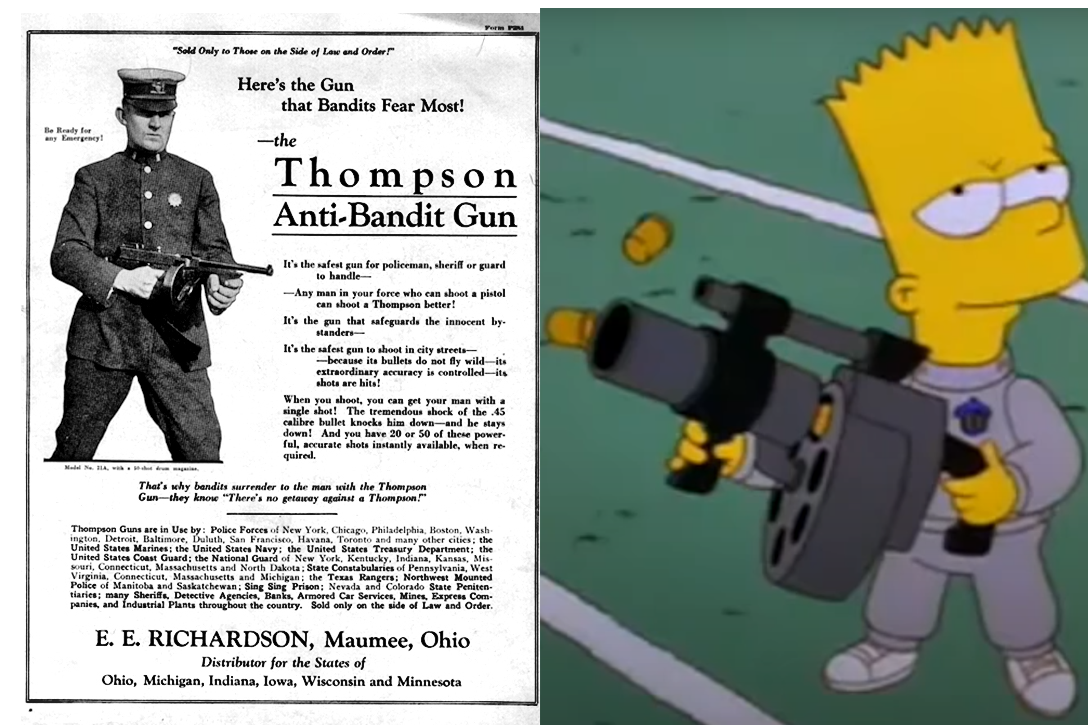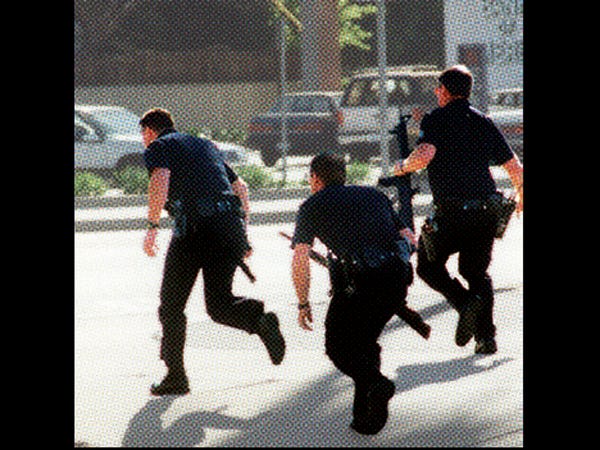
A Friday morning in North Hollywood
Cops carrying rifles are not a new phenomenon. But sometime between prohibition and The Simpsons, the weapons went out of fashion at police departments across the US.
Then February 28, 1997, happened—a day no one in Ohio likely remembers except any cop who was on the job that day 25 years ago. Incidentally, almost all of the top-ranking officers serving our city in 2020 had been around that long.

That morning, Larry Phillips, Jr., and Emil Matasareanu, dressed in full body armor, entered a bank in North Hollywood, California, with AKM fully automatic and HK-91 semi-automatic rifles intent on robbing it. 44 minutes later they were dead after a fierce gunfight that involved over 300 officers, almost 2000 rounds of ammunition, and some guns that officers had driven to gun stores to borrow. Eleven officers and seven civilians were injured, but thankfully none were killed.
DRMO - 1033 Program
At that point in time, the Los Angeles police department did not issue rifles to its patrol officers. The attempted robbery sent shockwaves through every law enforcement agency in the county. They collectively determined they would not be outgunned like that again.
They found it rather convenient that the US Department of Defense had started their 1033 program in 1985 through DRMO, short for the Defense Reutilization Marketing Office, which was a big box store that made nearly-new military equipment available to police departments at up to 99% off.
The Columbus Police Department purchased never-used Vietnam-era M16A1 rifles for pennies on the dollar. They installed rifle racks in the cruisers. They trained their patrol officers to use them. Estimates range from between 350 and 500 rifles that CPD purchased with this program.
SWAT
During the years that patrol officers did not carry rifles, the newly developed SWAT (Special Weapons and Tactics) Unit, established in 1974, became a highly trained 24/7 force that responded in hostage and other intense situations where rifles would be useful. The SWAT and In-Tac Units currently use fully automatic rifles purchased by the Division. The Division also pays for the $200 Tax Stamp required to carry these weapons.
Fully Automatic Rifles: 1 trigger pull = up to the entire clip fired
(can be used in semi-automatic mode)
Semi-Automatic Rifles: 1 trigger pull = 1 round fired
Directive 2.03 - Firearms Regulations
Columbus Division of Police officers are permitted to carry a personal weapon in addition to their service weapon. They are also permitted to conceal carry a personal weapon when off-duty. The rules were established in 1987 by Directive 2.03 and most recently updated on March 30, 2020.
Section U of the directive covers rules regarding Patrol Rifles and refers to the Patrol Rifle Officer (PRO) certification that officers can receive. It mentions that the rules also apply to any approved personally owned patrol rifle.
In 2020, the officers who wanted to certify as a PRO could use an M161A provided by the Division. Spending their own money on a rifle made little sense, especially since rifles normally cost more than the $300 the Division will reimburse the officer if the rifle is damaged or lost while they are on duty.
Demilitarization Initiatives
As the summer of 2020 brought the Columbus Division of Police and some of its dusty DRMO equipment into the streets of downtown, a lot of people were shocked at the “militarization” of our police department. Not the least of whom was Elizabeth Brown, President Pro-Tem of the Columbus City Council. By June of 2022 council had voted to restrict the use of “military-style equipment and tactics” as part of an ongoing effort to rebuild trust in local law enforcement.
The 20” M161A rifles were sent back to DRMO.
Personal rifles replace the M16s
The PROs went rifle shopping. There are five rifle models currently approved for purchase from various manufacturers. All are the Arma-Lite (AR) style frame with a 16” barrel.
Because each officer must recertify with their personal weapon each year, I requested the list of officers who have been certified in the past year. You can find that list here. You may recognize a few names in the 214 officers listed.
What you won’t see is a representative number of women on the list. Only one name pops out as probably female. We don’t know what this means. Are women discouraged from certifying? Do they have a different attitude about the role of rifles in their job? Or do they not believe they should spend their own money on work tools? No one could offer an explanation other than Brian Steele, Vice President of the FOP Lodge 9, who guessed it might be due to the strict size requirement of the rifles. But that doesn’t track with the actual military practice of issuing the same size M16 rifles to both men and women.
The policy states that after an officer leaves a patrol unit for another assignment they can continue to recertify with a supervisor's permission. The list does include several officers who are not responsible for patrol duties, but as we saw in 2020, the Division can mobilize everyone when they see a need.
Another incentive to continue to recertify is that the Division provides 60 rounds a week for range practice with the rifle. If you like to shoot and don’t like the current cost of ammunition, this is a heck of an employee benefit and would pay back the cost of the rifle in about six months.
We didn't learn which makes and models of the five approved rifles each officer has purchased. The records office stated that it only has 128 unique serial numbers in its system. When I asked for clarification, I was told it had closed my request and to start again, which means another four-month wait in its state of non-compliance with the Freedom of Information Act (FOIA). Stay tuned.
The war on guns
At the same time the Division is actively engaged in removing illegal weapons from the community, they are building a self-selected, male-dominated, rifle-armed group of patrol officers that compete with each other for the opportunity to deploy their weapons.
Erick Bellomy, President of the Ohio Chapter of the Brady Campaign, a national gun reform organization, sees the need for rifles in mass shootings where distance may be needed. But he is disheartened that an officer who chooses to purchase his own weapon may not be thoroughly vetted.
“I find that dangerous. I don’t see a need for rifles in any situation in a residential setting. It’s not something to brag about.” he said.
He would like assurance that those deploying rifles have frequent advanced training in both usage and storage.
Steele agrees. When asked what the union would like to change about the program, he said, “Training. We can always use more training.”
Accountability to City Council
In the legislation passed by the city council to reduce the ownership and deployment of military-style equipment, including rifles, they included a provision requiring the chief to submit a report each January for the previous year.
On or before January 30 of each year, the Chief of Police shall provide to Council a report on the deployment and use during the prior calendar year of all equipment regulated by Sections 1913.02, 1913.04, and 1913.05
(A) The frequency of which each unit of equipment was deployed;
(B) The location of deployment;
(C) The purpose for which equipment was deployed;
(D) The outcome of circumstances involving deployment;
(E) The cost associated with deployment;
(F) Complaints from residents regarding the deployment of equipment.
Chief Elaine Bryant delivered her report to Council Chair Shannon Hardin and Council Member Emmanuel Remy on January 24. She summarized her data by explaining that it took the Division from June until October to revise forms and drop-down boxes to track the requested actions. The paragraph reporting on the use of rifles follows:
The same issue of separate documentation was resolved in regards to the Patrol Rifle. Firearm displays by officers have been recorded using the P1 reporting system. For the entire year of 2022, there was a reported 3,865 displays of firearms by officers. That number includes the division issued handgun, shotgun and rifle. Starting in November of 2022, Policenet was able to add a drop down box on our P1 report for officers to specify when they displayed the patrol rifle. From November 1, 2022, until December 31, 2022, there were 66 incidents where officers displayed a patrol rifle. Zone 1 had 9, Zone 2 had 13, Zone 3 had 25, Zone 4 had 6, Zone 5 had 10, and 3 incidents were not labeled by zone or precinct.
The chief’s report discloses two months of frequency and general location, but nothing related to purpose, outcome, cost, or complaints about the rifle deployments. A general conclusion from this one view of the data is that nine percent of the firearm displays are rifles.
I will be reaching out to Councilmember Remy, Chair of the Public Safety Committee, to see if he was satisfied with this report and if he has asked for or received any follow-up documentation. Oversight of an agency that is accustomed to receiving no consequences when they submit incomplete or falsified reports intended to keep them accountable can be difficult.






The re-militarization of Columbus patrol officers with personally owned rifles